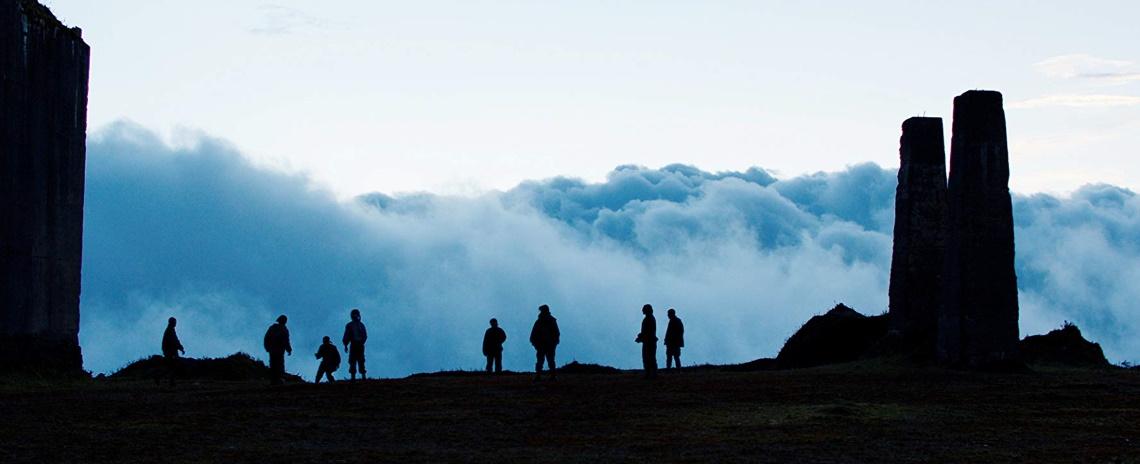It's the middle of the night when the woman Doctora (Julianne Nicholson) – as the American prisoner of an unnamed Colombian war is referred to by her teenage guerrilla captors – escapes from her jungle encampment. After hacking her way through dense forest thickets, she emerges at the confluence of two rivers. On the other side is a shore that appears to be identical to the one on which she stands. Director Alejandro Landes frames her – confused, destitute, discouraged – in a closeup in the left third of his shot before he pans right, circling what appears to be her point of view and evaluating the oppressive yet awe-inspiring ecosystem. The camera then appears to swing a full 360 degrees, perhaps to return to Doctora and observe her reaction – as a viewer has been trained to expect. Instead, by the time the shot completes its spin, she’s hundreds of feet away with her back to the camera.
Successful as this ostentatious move is at disorienting the viewer spatially and thus reflecting the character’s psychological confusion, the graceful shot is symptomatic of a major issue that afflicts Monos. Landes is a young filmmaker – this fever dream of a movie is only his second feature – and he attempts to synthesize his apparent influences into a form which instead largely removes them of any real depth or meaning. Russian master Adrei Tarkovsky’s spiritual philosophy is hinted at, but only in tempo and grandiose camera setups. Kubrick’s slow-burn existentialism is another hallmark, but here it feels closer to the lesser efforts from Nicholas Winding Refn, who frequently cribs from the late American director. Landes’ landscapes approach those of Mexican director Carlos Reygadas, whose Our Time, released stateside just this year, more evocatively related human animal urges to earthly matters. However, Monos does showcase Landes’ talent for movement, pacing, composition, and – given the praise from some critical corners following its premier at the Sundance Film Festival earlier this year – it will surely become his calling-card film.
That’s not to damn this nevertheless involving and beguiling film with faint praise – there’s enough here to recommend it be seen and to be seen as big as possible – but in an age dominated by visually rote blockbusters and long-form small-screen wonders, there is an emergent tendency to overpraise any cinematic ambition. Monos does have that quality in spades, at least in terms of its structure and themes. The bifurcated narrative, from a script co-written by Landes and Alexis Dos Santos, smartly withholds information to suspend the viewer in constant state of dislocation. Plopping them in medias res into a mountaintop military exercise, a diminutive drill sergeant only referred to as Messenger (Wilson Salazar), performs roll call on his eight child soldiers (“monos”) when he drops by to check in on their progress. While there, he charges them with a vital task, second only to keeping an eye on Doctora: caring for the precious mascot cow provided by “The Organization,” the faceless paramilitary group to which they belong.
Shortly thereafter, the group’s leader, Wolf (Julián Giraldo), is prompted by a female counterpart, Lady (Karen Quintero), to announce his intention to “partner” with her, but only after he learns a thing or two about kissing from his “brother,” the androgynous teammate Rambo (Sofia Buenaventura). The subsequent union party is a ritualistic endeavor, with all members donning warpaint as well as their daily military garb. A flurry of red and white smoke partially obscures the flurry of drunken activity, and Landes seems to cut to Mica Levy’s score rather than the inverse. The composer’s avant-garde percussive droning throughout doesn’t quite marry with these images in the same way that her masterful music for Under the Skin (2014) and Jackie (2016) enhanced those masterpieces with existential dread. The festivities lead into a morning afterparty in which Dog (Paul Cubides) and Bigfoot (Moisés Arias), automatic rifles in tow, proceed to fire bullets aimlessly into the air. This brazen and careless flex causes the death of the sacred animal whose care they’ve been entrusted with, and a spiral into intra-group violence reveals these isolated kids aren’t just playing games.
This initial setup bears some resemblance to William Golding’s canonical novel Lord of the Flies, and the influence is made apparent as the second half shifts from the cloudy mountaintops into the mosquito-infested jungle. Power dynamics mutate as Bigfoot takes control of the group, but he proves to be a much less even-keeled leader than Wolf, prone to masochistic outbursts. Flies also acts as an influence on the group diegetically, in that the novel’s most vivid symbol – a decaying pig’s head on a stick – is repurposed as a means of torture for Smurf (Deibi Rueda) following an act of betrayal. Even the film’s title, which translates to “monkeys,” and the characters’ crude, animalistic monikers reinforce Golding’s humans-as-beasts metaphor.
In keeping the Organization's politics vague, Monos also resembles Bertrand Monello’s great 2017 teenage terrorist drama Nocturama, in which a group of disaffected youths hole up in a shopping mall after-hours, after having just bombed several Parisian government buildings. Both films remove any political association from their respective groups, allowing the latter to act as a screed against capitalistic urges and the former exploring more base human ones. A pair of scenes between Doctora and Swede (Laura Castrillón) are a perfect distillation of Landes’ thesis. In an underground bunker, with a never-seen battle unfolding above them, the young warrior faces the American hostage with her rifle. “Have you ever actually killed anyone?” Doctora asks before the two regress into a display of psychosexual one-upmanship. In an analogous later scene between the two, their game turns deadly, proposing that, stripped of personhood or recognizable compassion, humans are more than capable of participating in Darwin’s “survival of the fittest.”
Rating: B


